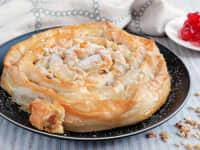As Oxfordshire Artweeks celebrates the elements of the earth and the art made with them, Esther Lafferty talks to potter Debbie Page https://www.artweeks.org/galleries/2020/debbie-page-ocg-woa who uses white earthenware clay to hand-build vessels inspired by the strong, simple lines of Korean & Japanese pottery.
Her collection includes pails with driftwood handles which reflect the Japanese water pail, and Moon Jars, Earth spheres and teapots too. ‘I love clay,’ she says, smiling. ‘I love the way you can take a lump of mud and fashion it into a form of your choosing. Clay does have character though,’ she laughs, ‘so it will roll and curl when you’d rather it didn’t! I always made things ever since I can remembers, with plastercine or sand, and then in my teens I did a year of pottery at school and that was it - I was hooked!’ In my twenties, I discovered ancient Japanese Jomon pottery, the proven oldest vessels found anywhere on the planet. There are whole pots which date back a mind-blowing fifteen thousand years, and on them you can see the fingerprints of the maker in the patterns they decorated it with. It’s incredible to see that link with people a world apart from us today. They were just coming out of the ice age in Japan and they wanted to have beautiful things in their lives too. I didn’t set out to create pieces the same shapes: it just happened subconsciously.’
Debbie’s pails are organic in colour – a honey, a dark green, a teal green she discovered by accident and a the occasional brighter red or blue! ‘I like to use an old-fashioned crackle glaze to part-glaze the pots which I then smoke fire, to accentuate the crackle effects and depth of colour and add smoke tones to the naked clay.’ she explains. I was also fascinated to discover that there was a ‘pottery war’ between Japan and Korean in the late sixteenth century when both considered themselves to be at the forefront of ceramics. There’d always been industrial espionage but then the Japanese invaded a particular village well known for its pottery and kidnapped all the potters, taking them back to Japan to steal their techniques! The Korean influences still remain in some Japanese pots.
The spherical pots Debbie makes are influenced by the porcelain Korean Moon jar - an iconic style from three hundred years ago, called moon jars because of their shape and the milky white glaze. Debbie’s moon jars were burnished and smoke fired to give a more lunar-like appearance than the white of the Korean Moon Jars and then, experimenting with blue, green and white palette of glazes and the occasional spot of red she began to make Earth Jars and Earth discs with dramatic effect. ‘I also use the technique of kintsukuroi - the repairing of broken ceramics originally with lacquer and gold dust,’ says Debbie ‘ as I have long admired the Japanese concept of Wabi Sabi, seeing beauty in imperfection: like the gold and the smoke glaze, it’s all added character!’
For more, visit: https://www.artweeks.org/festival/theme/elements-earth







